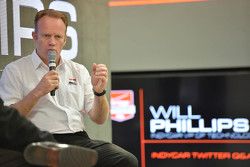IndyCar competition rules tweaks coming for 2016
Will Phillips has confirmed the 2016 IndyCar season will see qualifying changes to the Indy 500, the return of double points and shorter yellow flag periods.

Photo by: IndyCar Series








Phillips has noted there will be a revision to the points system for next year's 100th Indianapolis 500, which is expected to be revealed before Christmas.
Although he wouldn't go into specific details before they had been revealed to the teams, Phillips told Motorsport.com: "The points will only be given on the Sunday. The principles will be the same, in that the Top Nine will be locked in on Saturday and their order decided on Sunday.
"But the details in how or when the points are distributed is different – just Sunday, not Saturday and Sunday."
Phillips added: "There are so many 'What if…?' scenarios because we don't know yet how many cars and entries there will be [for the Indy 500]. So we've got to cover whether the last row can change and who will be 'bump-able' from the field.
"But the long and short of it is that Saturday gets you into the show, Sunday decides where you start."
The Indy 500 will again be worth double points, as will the championship finale at Sonoma. This year's race saw Chip Ganassi Racing's Scott Dixon overhaul Team Penske's Juan Pablo Montoya by the narrowest of margins as the Kiwi won the double-points decider and the title with it.
Observed Phillips: "To have a tie-breaker deciding the title, it doesn't get much better. That has to be put down as a good result and so that won't change."
Shortened cautions
Phillips admitted that one of IndyCar's aims for 2016 is to shorten the full-course caution periods.
"Any ways in which we can do that have been examined because that has been a criticism we've faced," he said. "So one of the ways we can reduce yellow time is by speeding up the process of checking the order of the field, and you do that by going back to a specific time line prior to the yellow being called.
"What you don't want though, is to do that on, say, the last lap of the Indy 500, when it might determine the outcome of the race. So perhaps we'd say that for the first three-quarters of the race, we have that process in place where we go back to the timeline, but in the closing stages, have a different system to determine who was in front."
Regarding the possibility of reducing the number of full-course cautions "at source" – by having stricter regulation of driving standards, and therefore fewer incidents – Phillips said he did not see driver discipline as being a particular cause for concern in IndyCar.
He said: "That will be down to [race director] Brian Barnhart. But I don't think the drivers could have raced as long and as close as they did at Fontana without incident if there wasn't already a lot of respect between the drivers.
"Obviously the race conditions and downforce package had them racing a lot closer than we intended."
On that matter, Phillips reiterated what he told Motorsport.com last month – that downforce changes on ovals are extremely unlikely over the course of a race weekend.
"If we get our numbers right, we shouldn't need to make last-minute changes," he said. "We always learn from previous years, and I think we learned things in 2015 that will help us get it right for 2016.
"The challenges will be new tracks to this car, such as Phoenix. We'll have people at the tests there, and if we need to make a change that's safety-related, then we'll do that.
"But our intention is, once we've published the rules, we then stick with them. That's what the teams would like. They don't want to test the cars a certain way and then think they've wasted a day's testing because of an eleventh-hour regulation change on race weekend."
Aero updates
Regarding the much-discussed developments that Honda have been permitted under Rule 9.3, in order to allow HPD to catch up with the superior Chevrolet aero kit of 2015, Phillips said: "We haven't quite finished our process there.
"There is also still open homologation under Rule 9.2 – which covers the three development boxes in which both manufacturers are allowed to update their kit for 2016. We haven't seen everything the manufacturers want to do yet."
Asked if IndyCar might carry out its independent aero test prior to the 2016 season in order to ensure that neither manufacturer has a major advantage throughout the season, Phillips said: "We're putting some of our own methods in place to allow us to do that. We want to have the data at our own fingertips this year, not rely on the manufacturers to give it to us."
Be part of Motorsport community
Join the conversationShare Or Save This Story
Subscribe and access Motorsport.com with your ad-blocker.
From Formula 1 to MotoGP we report straight from the paddock because we love our sport, just like you. In order to keep delivering our expert journalism, our website uses advertising. Still, we want to give you the opportunity to enjoy an ad-free and tracker-free website and to continue using your adblocker.















Top Comments